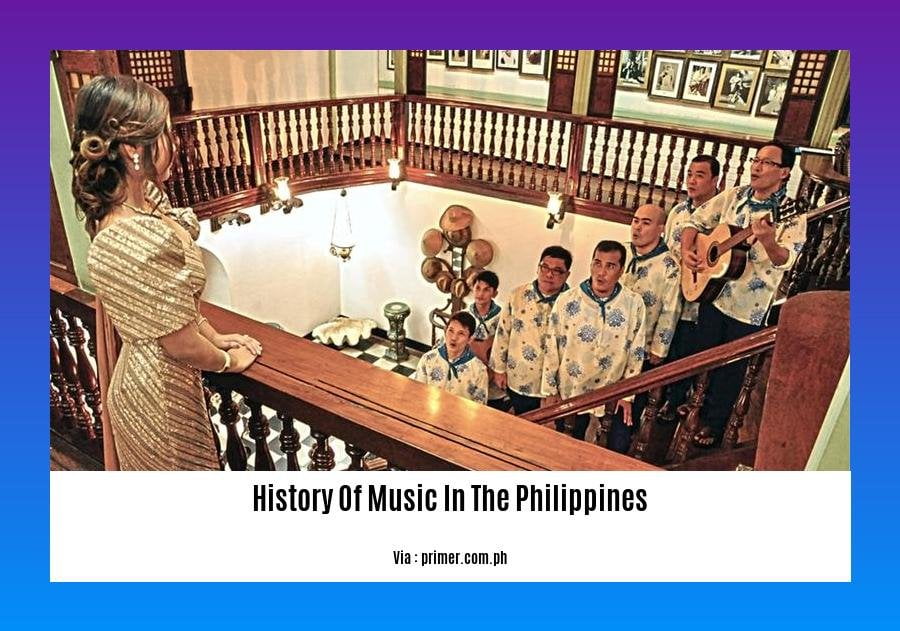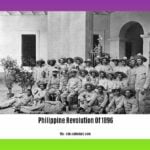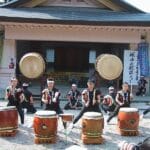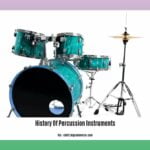Embark on a captivating journey through the rich tapestry of Philippine music in [Unveiling the Melodies of the Past: Exploring the History of Music in the Philippines]. Unravel the stories behind the vibrant sounds that have shaped the nation’s cultural identity, from ancient indigenous traditions to the global influences that have left their mark.
Key Takeaways:
Pre-colonial music was mainly used for religious ceremonies and rituals, with instruments like drums, gongs, bamboo flutes, and kulintang.
During the Spanish colonial era, European influences introduced new instruments and musical forms, leading to the development of the rondalla and Filipino composers like Francisco Santiago and Juan Crisostomo Ibarra.
American colonization brought jazz, blues, and rock and roll, contributing to the emergence of Filipino popular music and musicians like Apl.de.ap, Bruno Mars, and Lea Salonga.
Post-colonial music has seen the fusion of global influences, leading to new genres like hip-hop and electronic music, and the rise of Filipino musicians such as Bamboo Manalac, Sarah Geronimo, and Yeng Constantino.
History of Music in the Philippines
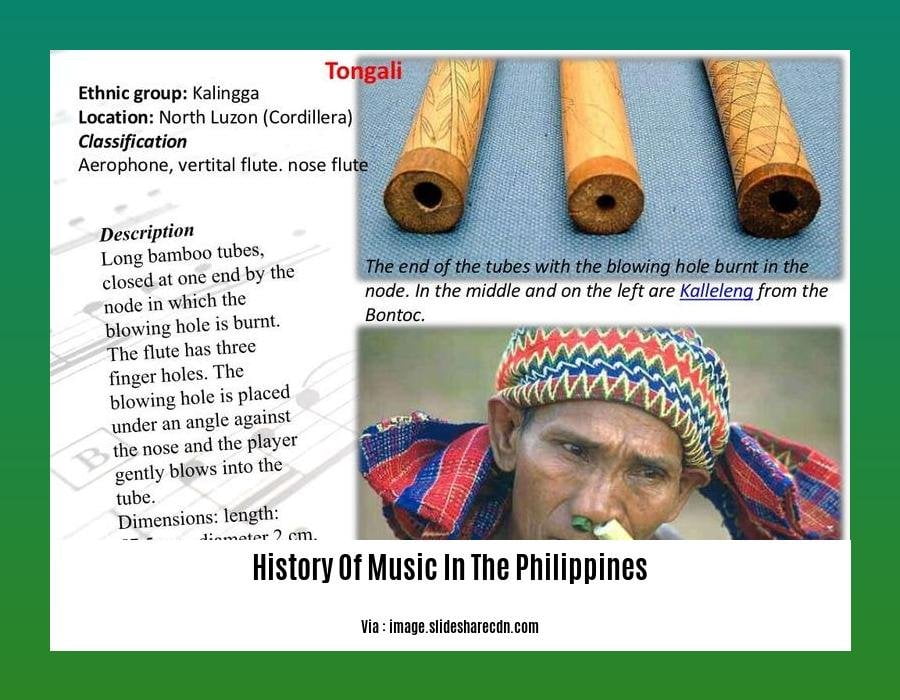
Immerse yourself in the rich tapestry of Philippine music as we delve into its vibrant history, Exploring the diverse influences, unique soundscapes, and iconic figures that have shaped the musical heritage of the Philippines.
Pre-Colonial Era: Indigenous Rhythms and Rituals
Before the arrival of foreign influences, music in the Philippines was deeply intertwined with indigenous beliefs and practices. Traditional instruments, such as drums, gongs, bamboo flutes, and stringed instruments like the kulintang, echoed through the land. These soulful melodies were woven into the fabric of rituals, ceremonies, and daily life, serving as a sacred connection to ancestral spirits and natural forces.
Colonial Era: European Influences and Cultural Fusion
The arrival of Spanish colonizers brought about a fusion of musical traditions. European instruments and musical forms, such as the guitar, violin, and piano, blended with indigenous sounds, giving birth to unique genres like the rondalla. Filipino composers, such as Francisco Santiago and Juan Crisostomo Ibarra, emerged as pioneers, incorporating Western classical music elements into their compositions while retaining distinctly Filipino rhythms and melodies.
American Colonial Era: Jazz, Blues, and a New Musical Landscape
The American colonial period ushered in a fresh wave of musical influences. Jazz, blues, and rock and roll swept the nation, captivating Filipinos with their infectious rhythms and soulful expressions. Local musicians eagerly embraced these new genres, blending them with traditional sounds to create a vibrant and dynamic musical landscape. Filipino popular music, a fusion of East and West, flourished, giving rise to iconic musicians like Apl.de.ap, Bruno Mars, and Lea Salonga, who would later grace international stages.
Post-Colonial Era: Embracing Diversity and Global Sounds
Following independence, Philippine music continued to evolve, absorbing influences from around the world. New genres, such as hip-hop and electronic music, emerged, reflecting the country’s growing cosmopolitanism. Filipino musicians, inspired by global trends, fused traditional elements with contemporary sounds, resulting in a vibrant and diverse musical scene. Artists like Bamboo Manalac, Sarah Geronimo, and Yeng Constantino rose to prominence, capturing the hearts of Filipinos with their unique blend of traditional and modern musical expressions.
Throughout its history, the history of music in the Philippines has served as a mirror, reflecting the nation’s rich cultural heritage, resilience, and openness to new influences. It is a testament to the Filipinos’ creativity, adaptability, and unwavering passion for creating music that resonates with the soul.
Uncover the captivating history of mugs and discover how these humble objects evolved from simple containers to cultural icons.
Explore the history of music genres and immerse yourself in the evolution of sound, from ancient chants to modern-day melodies.
Delve into the history of nail care and uncover the fascinating journey of how this art form transformed from a practical necessity to a symbol of beauty and self-expression.
Emergence of National Identity: Music in the Philippine Revolution
Throughout history, music has served as a powerful force in shaping national identity, and the Philippine Revolution was no exception. Let’s delve into how music played a pivotal role in galvanizing Filipinos towards independence.
Bayan Ko: A Song of Hope and Unity
Among the most iconic songs to emerge during the revolution was “Bayan Ko” (My Country), a stirring anthem that captured the Filipinos’ yearning for freedom and unity. Originally written in Spanish by José Corazón de Jesús, the song was translated into Tagalog by Constancio de Guzman, a renowned musician and composer.
Combining heartfelt lyrics with a poignant melody, “Bayan Ko” eloquently expressed the Filipinos’ love for their homeland and their determination to break free from colonial rule. The song quickly gained popularity, becoming a rallying cry for revolutionaries and a symbol of national unity.
Music as a Catalyst for Revolution
Music became a potent tool for the revolutionaries to spread their message and mobilize the masses. Musicians, poets, and composers actively used their talents to create songs, poems, and musical pieces that ignited the spirit of patriotism and inspired Filipinos to join the fight for independence.
These works of art, often performed at clandestine gatherings and secret meetings, played a crucial role in keeping the revolutionary movement alive. They fueled the people’s resolve, provided a sense of solidarity, and reminded them of the cause they were fighting for.
Post-Revolution Influence and Legacy
Even after the revolution, music continued to play a vital role in shaping the newly independent nation’s identity. “Bayan Ko” remained a beloved song, often performed at national events and patriotic gatherings, serving as a reminder of the sacrifices made and the unity achieved during the struggle for independence.
Filipino composers and musicians drew inspiration from the revolutionary songs, incorporating themes of nationalism and patriotism into their works. This led to the creation of a rich body of music that celebrated the nation’s heritage and identity, contributing to the development of a distinct Filipino musical style.
Key Takeaways:
“Bayan Ko” emerged as a powerful symbol of unity and a rallying cry for Filipino revolutionaries during the Philippine Revolution.
Music served as a potent tool to spread the revolutionaries’ message, mobilize the masses, and keep the revolutionary movement alive.
Post-revolution, music continued to play a crucial role in shaping the national identity, inspiring composers to create works that celebrated the nation’s heritage and identity.
Filipino music remains a vibrant and diverse art form, reflecting the nation’s rich history, cultural heritage, and ongoing journey of self-discovery.
Citations:
Evolution of Contemporary Filipino Music: Popular Genres and Artists
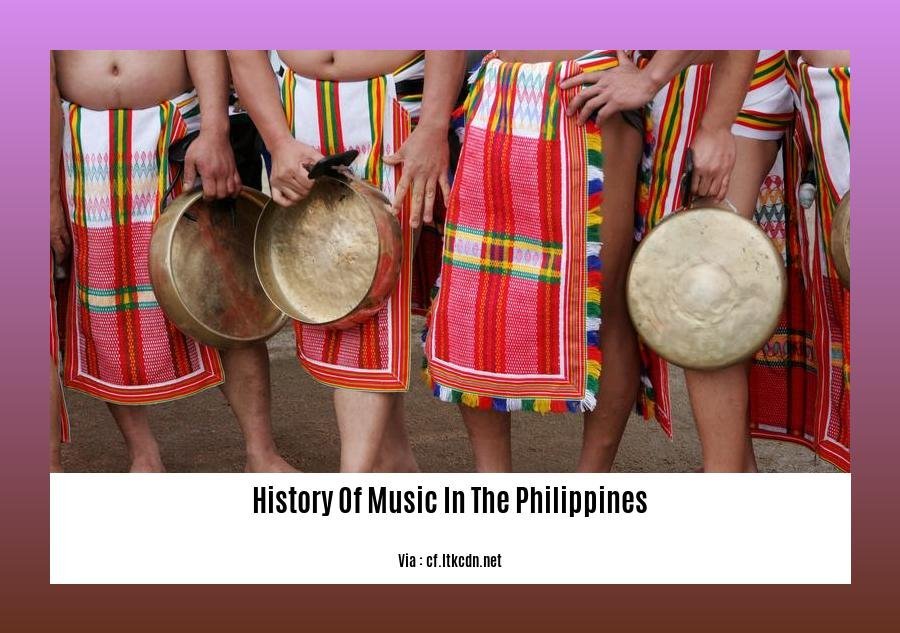
As we delve into the captivating world of Philippine music, we embark on a journey through the metamorphosis of contemporary Filipino music, exploring the vibrant tapestry of popular genres and the trailblazing artists who have shaped its evolution.
The Enchanting Melody of OPM
Emerging in the 1970s, Original Pilipino Music (OPM) heralded a new era in Philippine music, championing the use of the native language and showcasing stories that resonated deeply with the Filipino soul. Pioneers like Freddie Aguilar, Asin, and APO Hiking Society paved the way for this genre, captivating audiences with their heartfelt ballads and infectious melodies.
The Rhythmic Pulse of Pinoy Rock
The 1980s witnessed the rise of Pinoy rock, a genre that fused traditional Filipino sounds with Western rock influences. Bands like Juan de la Cruz, The Dawn, and Rivermaya led the charge, igniting a musical revolution that captured the zeitgeist of a nation yearning for change. Their anthems of freedom, love, and social justice resonated with Filipinos from all walks of life.
The Harmonic Convergence of Pop and R&B
The 1990s ushered in a new wave of Filipino pop and R&B artists who blended international sounds with Filipino sensibilities. Singers like Regine Velasquez, Martin Nievera, and Gary Valenciano emerged as superstars, captivating audiences with their vocal prowess and chart-topping hits. Their music transcended borders, introducing Filipino talent to the global stage.
The Urban Revolution: Hip-Hop and Beyond
The 21st century brought forth a surge of hip-hop and rap artists who injected a fresh energy into the Philippine music scene. Gloc-9, Francis M, and Abra led the charge, using their music as a platform to address social issues and tell stories from the streets. Their raw and powerful lyrics resonated with a new generation of listeners, pushing the boundaries of Filipino music.
Electronic Dance Music: A Global Beat
In recent years, electronic dance music (EDM) has taken the Philippines by storm. DJs and producers like DJ Euric, Ace Ramos, and Mars Miranda have emerged as pioneers of this genre, crafting infectious beats that have captivated audiences at music festivals and dance clubs across the country. Their music has put the Philippines on the global EDM map, showcasing the country’s vibrant electronic music scene.
Key Takeaways:
Original Pilipino Music (OPM) emerged in the 1970s, championing Filipino language and stories.
Pinoy rock, a fusion of traditional Filipino sounds and Western rock, gained popularity in the 1980s.
Pop and R&B artists like Regine Velasquez and Martin Nievera achieved international success in the 1990s.
Hip-hop and rap artists like Gloc-9 and Francis M emerged in the 21st century, addressing social issues through their music.
Electronic dance music (EDM) has recently gained popularity in the Philippines, with DJs like DJ Euric leading the scene.
Citation:
Filipino Music: A History by Doreen G. Fernandez
The Evolution of Filipino Popular Music by Ricardo D. Trimillos
The Future of Philippine Music: Global Influences and Local Identity
In this era of globalization, music knows no bounds. New technologies and streaming platforms have bridged the gaps between cultures, allowing artists from all corners of the world to connect, collaborate, and influence one another like never before. This, of course, has had a profound impact on the future of Philippine music, leading to exciting new developments and challenges for our local musicians.
The Rise of Global Influences
Today, Filipino musicians are more exposed to global trends and sounds than ever before. Thanks to the internet, they can easily listen to music from different countries, discover new genres, and collaborate with artists from various backgrounds. This has led to a healthy exchange of ideas and the emergence of new musical styles that blend traditional Filipino elements with international influences.
While some may view this trend as a threat to our local identity, I believe it presents a unique opportunity for Filipino musicians to grow and expand their horizons. By embracing global influences, they can create music that resonates with a wider audience while still staying true to their roots.
The Importance of Local Identity
In the face of globalization, it’s more important than ever for Filipino musicians to maintain their unique identity. This means staying connected to our cultural traditions and finding ways to incorporate them into our music. It also means telling our own stories and experiences in a way that is authentic and relatable to our audience.
By embracing our local identity, we can create music that is truly Filipino and that stands out from the crowd. We can also help to promote our culture on a global stage and inspire other musicians to explore their own roots.
Striking the Balance
The key to the future of Philippine music lies in striking a balance between global influences and local identity. Our musicians need to be open to new ideas and sounds while still staying true to their heritage. By doing so, they can create music that is both unique and universal, that speaks to the hearts of Filipinos all over the world.
Key Takeaways:
- Globalization has had a profound impact on the future of Philippine music, leading to both positive and negative consequences.
- Filipino musicians are now more exposed to global trends and sounds, which has led to the emergence of new musical styles that blend traditional Filipino elements with international influences.
- While some may view this trend as a threat to our local identity, others see it as a unique opportunity for Filipino musicians to grow and expand their horizons.
- It’s more important than ever for Filipino musicians to maintain their unique identity in the face of globalization.
- The key to the future of Philippine music lies in striking a balance between global influences and local identity.
- By embracing our local identity, we can create music that is truly Filipino and that stands out from the crowd.
Relevant URL Sources
– The Philippine Popular Music Industry: Technologies of Music in the Changing Ecologies of Sound
– A Brief History of Philippine Music
FAQ
Q1: What are some of the unique characteristics of pre-colonial Philippine music?
A1: Pre-colonial Philippine music was characterized by its use of indigenous instruments such as gongs, drums, flutes, and string instruments. Vocal music was also prevalent, with a rich tradition of folk songs, epics, and lullabies. Music played a vital role in religious ceremonies, rituals, and storytelling.
Q2: How did the Spanish colonization influence Philippine music?
A2: The Spanish colonization brought significant changes to Philippine music. European instruments and musical forms were introduced, leading to the development of new genres such as the rondalla, a string ensemble that remains popular today. Filipino composers like Francisco Santiago and Juan Crisostomo Ibarra emerged during this period, creating music that blended indigenous and European elements.
Q3: What was the impact of American colonization on Philippine music?
A3: American colonization brought new influences to Philippine music, including jazz, blues, and rock and roll. This led to the development of Filipino popular music, which combined traditional and Western elements. Notable Filipino musicians such as Apl.de.ap, Bruno Mars, and Lea Salonga emerged during this period, gaining international recognition.
Q4: How has Philippine music evolved in the post-colonial era?
A4: In the post-colonial era, Philippine music has continued to evolve and incorporate diverse influences from around the world. New genres such as hip-hop and electronic music have emerged. Filipino musicians like Bamboo Manalac, Sarah Geronimo, and Yeng Constantino have gained prominence, showcasing the dynamic and ever-changing nature of Philippine music.
Q5: What are some of the significant contributions of Philippine choral music to the country’s musical heritage?
A5: Philippine choral music has a rich history, with roots in church choirs and now widely featured in universities, schools, and communities. Filipino choral arrangers like Robert Delgado, Fidel Calalang, Lucio San Pedro, and Eudenice Palaruan have made significant contributions to the development of choral music in the country. Choral music plays a vital role in preserving and promoting Filipino culture and identity.
- Star Ring Trends: Etsy vs Amazon - March 28, 2025
- Boost Pollinator Habitats: Baby Blue Eyes Sustainable Farming Guide - March 28, 2025
- Protect Big Black Bears: Effective Conservation Strategies - March 28, 2025
